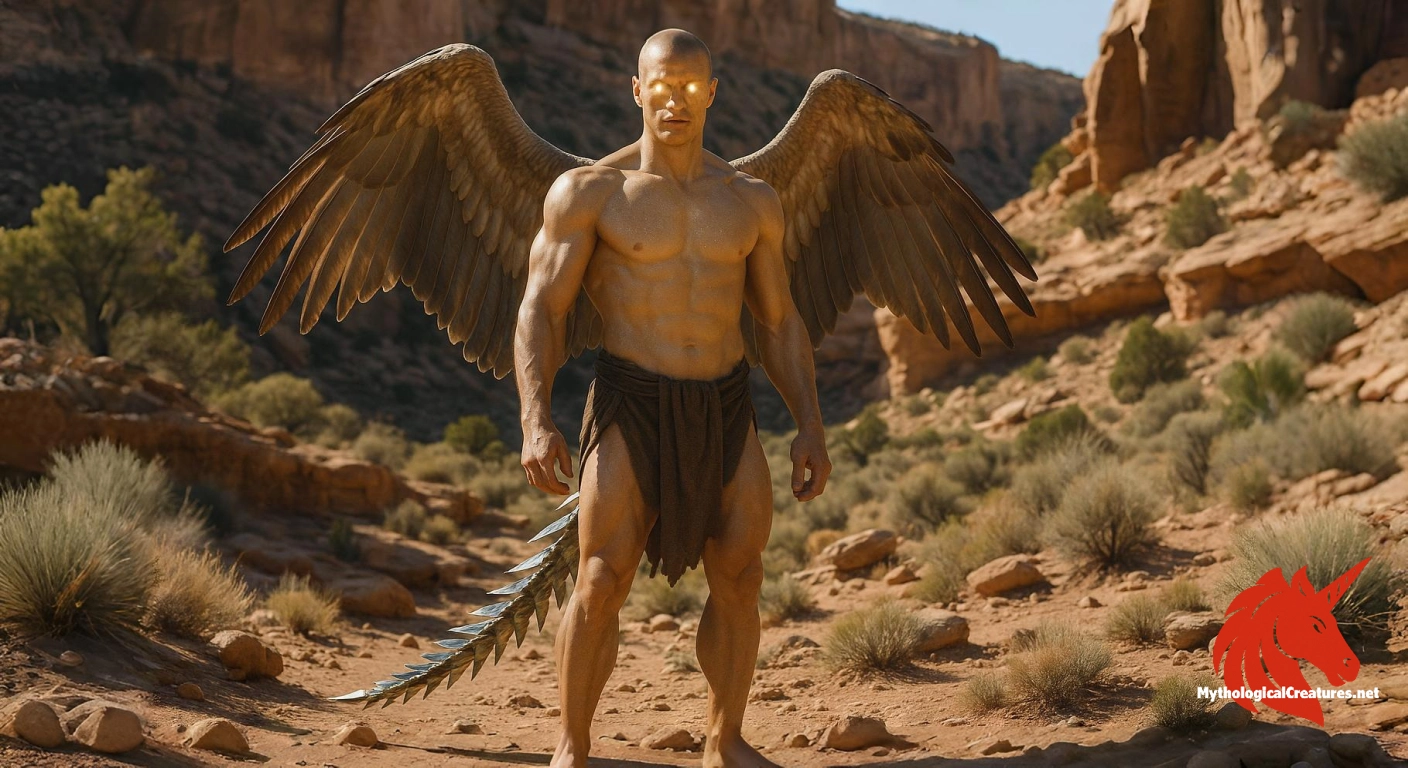Achiyalatopa: Achiyalatopa is a celestial figure in Zuni mythology known for its unique ability to fly and a tail fashioned from flint knives.

Achiyalatopa
Achiyalatopa - Achiyalatopa is a unique mythical figure whose celestial powers and distinctive physical attributes have left a mark on Zuni cultural lore.
Origins & First Encounters
Achiyalatopa emerges as one of the most enigmatic figures in Zuni mythology, revered for its potent celestial essence and transformative role in traditional narratives. It is often depicted as a being whose origins intertwine with the ancient spiritual fabric of the Zuni people, echoing mysteries that predate written history. Emerging from a milieu of oral storytelling, its first attestations were interwoven with ritual practices and cosmic ceremonies. The figure is celebrated for bridging the ethereal and the mundane, embodying qualities that resonate with both divine protection and existential challenge. Its presence in early narratives symbolises not only the awe-inspiring power of the heavens, but also a profound connection to the earth and natural order. Over time, Achiyalatopa has become a metaphor for the disruptive forces that reshape tradition and community identity. The creature’s legacy has influenced generations by inspiring allegories of creation, destruction, and transformation. In its multifaceted portrayal, every detail—from its weaponised tail to its celestial wings—speaks to the complexity of indigenous belief systems. This rich tapestry of myth continues to invite curiosity and reverence among those who explore the spiritual heritage of the American Southwest.
Source Texts & Tale Variants
Ancient anthropological records and oral traditions form the primary wellspring of narratives about Achiyalatopa, preserving its lore through generations of Zuni tradition. The figure’s legend has been maintained by storytellers who pass down intricate details through ritual and ceremonial recitations. Diverse accounts within the folklore emphasise its celestial powers and martial prowess, particularly the unusual depiction of its tail made of flint knives. Some versions of the tale mention that Achiyalatopa imparted the art of sword swallowing to two chief officers of the Hle'wekwe Fraternity, adding an element of human intervention to its mythic character. Variants of the story have been collected during early ethnographic studies, revealing subtle differences in how the power and personality of the figure were understood. Each version contributes layers of meaning that illustrate the interplay between divine inspiration and earthly practise. Over successive generations, these narratives have grown richer, adopting local nuances while retaining a core of cosmic significance. Modern folklorists have noted that while the textual evidence remains sparse, the enduring elements of the myth underline universal themes of power, transformation, and ritual competence. Such diverse sources continue to spark scholarly interest and cultural pride in the legacy of Achiyalatopa.
Form & Powers
Visually, Achiyalatopa is depicted as a striking and otherworldly figure whose form radiates an ethereal luminescence intertwined with tangible martial details. The creature boasts expansive wings that appear to be fashioned from an array of glistening flint knives, each edge catching the light in a display of celestial artistry. Its tail, intricately designed and equally formidable, is composed of sharp, polished stone fragments that evoke both beauty and lethal purpose. The overall construction of its anatomy suggests a creature that is both imposing and agile, with contours that seem to shift between mortal scale and cosmic grandeur. Notably, the eyes of Achiyalatopa are often portrayed as deep, reflective pools, hinting at a wisdom that spans the cosmos and an inner tumult of untold memories. Variations in artistic depictions sometimes show it as an enormous, awe-inspiring presence, while other depictions render the figure as more subtle and ethereal, adapting to the needs of the narrative. The interplay between the rigid, carved quality of the flint and the flowing, almost spectral aspects of its form creates a dynamic tension that is both captivating and intimidating. This harmonious yet paradoxical design underscores its role as a mediator between the earthly realm and the vast unknown, challenging observers to reconcile beauty with brutality. Every detailed portrayal cements Achiyalatopa’s image as a masterful synthesis of natural elements and divine craftsmanship.
Regional Faces
Regional representations of Achiyalatopa reveal a rich tapestry of local adaptations that reflect the diversity of Zuni and neighbouring cultural traditions. In some communities, the myth emphasises its role as a guardian of celestial secrets, while other local narratives portray it as a formidable warrior whose presence foreshadows cosmic balance. Storytellers in different regions have tailored its attributes to resonate with locally revered symbols, thereby enriching the character with regional colour and nuance. Variations in the retelling often incorporate elements unique to local ceremonial practices, ensuring that the myth remains dynamic and contextually relevant. The distinctive quality of its flint knife tail, for instance, has been interpreted in some areas as a symbol of both protection and retribution. Localised versions sometimes merge its celestial side with aspects of earth-bound heroism, bridging the gap between mythic inspiration and everyday life. The intermingling of regional mythic motifs with the core attributes of Achiyalatopa speaks to a cultural dialogue that spans generations and communities. As these variations continue to evolve, they underscore the adaptive function of myth, enabling the figure to embody both universal and local ideals. This regional diversity underscores the enduring impact of indigenous storytelling and its capacity to adapt to changing cultural landscapes.
Cultural Parallels
Comparative studies of mythological figures reveal intriguing parallels between Achiyalatopa and other divine entities across cultures. Its portrayal, with celestial wings and a weaponised tail, resonates with the imagery of the Thunderbird from other Native American traditions, where nature and divinity are in constant interplay. Similar to how the Thunderbird controls the elements, Achiyalatopa embodies the force of cosmic phenomena through its flint-made appendages. In some Indo-European traditions, deities or mythical beasts also wield unconventional armour or weaponry forged from the natural world, establishing a cross-cultural motif of natural power harnessed by the divine. The dual nature of creation and destruction present in Achiyalatopa finds echoes in various mythic figures who embody both artistic brilliance and martial prowess. Comparative analysis further reveals that its multidimensional character reflects universal themes of transformation and the clash between order and chaos. The synthesis of celestial artistry with raw, destructive force found in its depictions echoes broader mythological patterns found across continents. Exploring these interconnections not only enriches the understanding of Achiyalatopa but also highlights the universal language of myth that transcends cultural boundaries. Such parallels invite a deeper contemplation of how human societies symbolise cosmic power and the eternal struggle between opposing forces.
Legacy & Modern Evolution
The myth of Achiyalatopa has continually evolved through centuries of reinterpretation and cultural exchange, adapting to both traditional and modern influences. While early accounts emphasised its formidable powers and enigmatic presence, contemporary portrayals have embraced a more nuanced symbolism that resonates with current artistic sensibilities. Over time, the figure has transcended its original ritualistic context, emerging as a symbol of indigenous resilience and the dynamic interplay between heritage and modernity. Modern reinterpretations often highlight the fusion of stark violence inherent in its flint weapons with a broader spiritual narrative centred on cosmic balance. Contemporary artists and writers have drawn on the rich visual and thematic elements of its legend to explore themes of transformation, power, and the passage of time. This evolving imagery has reinvigorated the myth for new audiences, ensuring that Achiyalatopa remains a vibrant part of indigenous cultural renaissance. Modern digital media and performance art have further broadened its appeal, allowing the figure to serve as a bridge between ancestral wisdom and innovative expressions of identity. The continual reinvention of its narrative demonstrates the enduring capacity of myth to inspire and challenge perceptions, assuring Achiyalatopa’s place as a timeless emblem of cosmic awe and artistic ingenuity. Its legacy remains a testament to the power of cultural memory and the endless possibilities inherent in myth-making.
Interesting Fact
An intriguing aspect of Achiyalatopa is its unusual tail, made entirely of flint knives, which it uses to perform precise projectile attacks.
Quick Creature Info
Origin:
Features:
Associations:
Our Mythic Legendary Rating:

Habitat:
Supernatural Powers:
Physical Attributes:
Abilities:
Behavior:
Lore:
Related Creatures, Tales or Lore
- TThunderbird
- QQuetzalcoatl
- GGaruda
References
Discover Another Mythical Legend You May Not Have Heard Of?
Uncover the mysteries of ancient folklore and expand your knowledge of legendary beings from cultures around the world.
Dare to Meet the Dirawong....
Curated by the Mythological Creatures Team (rev. May 2025)
